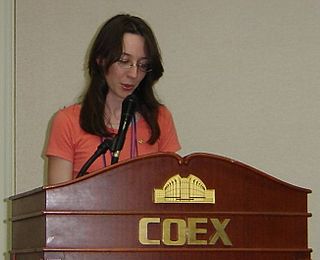Related Research Articles

The news media or news industry are forms of mass media that focus on delivering news to the general public. These include news agencies, newspapers, news magazines, news channels etc.

In journalism and mass media, sensationalism is a type of editorial tactic. Events and topics in news stories are selected and worded to excite the greatest number of readers and viewers. This style of news reporting encourages biased or emotionally loaded impressions of events rather than neutrality, and may cause a manipulation to the truth of a story. Sensationalism may rely on reports about generally insignificant matters and portray them as a major influence on society, or biased presentations of newsworthy topics, in a trivial, or tabloid manner, contrary to general assumptions of professional journalistic standards.
Youth-led media is any effort created, planned, implemented, and reflected upon by young people in the form of media, including websites, newspapers, television shows and publications. Originating in the 20th century alongside youth activism, efforts have been highly influenced in the 21st century by the introduction of social media.
Paid content is content on the Internet – such as text, graphics, video and downloads – which is paid for. Paid content is usually copyrighted.

Citizen media is content produced by private citizens who are not professional journalists. Citizen journalism, participatory media and democratic media are related principles.
Independent media refers to any media, such as television, newspapers, or Internet-based publications, that is free of influence by government or corporate interests. The term has varied applications.
The News Media Alliance is a trade association representing approximately 2,000 newspapers in the United States and Canada. Member newspapers represented by the Alliance include large daily papers, non-daily and small-market publications, as well as digital and multiplatform products. The organization has organized and hosted mediaXchange, the newspaper industry's annual conference.

An online newspaper is the online version of a newspaper, either as a stand-alone publication or as the online version of a printed periodical.

Digital journalism, also known as netizen journalism or online journalism, is a contemporary form of journalism where editorial content is distributed via the Internet, as opposed to publishing via print or broadcast. What constitutes digital journalism is debated by scholars; however, the primary product of journalism, which is news and features on current affairs, is presented solely or in combination as text, audio, video, or some interactive forms like storytelling stories or newsgames, and disseminated through digital media technology.
The Online News Association (ONA), founded in 1999, is a 501(c)(3) non-profit organization located in Washington D.C., United States. It is the world's largest association of digital journalists, with more than 2,000 members.
In communication, media are the outlets or tools used to store and deliver content; semantic information or subject matter of which the media contains. The term generally refers to components of the mass media communications industry, such as print media, publishing, news media, photography, cinema, broadcasting, digital media, and advertising.

A paywall is a method of restricting access to content, with a purchase or a paid subscription, especially news. Beginning in the mid-2010s, newspapers started implementing paywalls on their websites as a way to increase revenue after years of decline in paid print readership and advertising revenue, partly due to the use of ad blockers. In academics, research papers are often subject to a paywall and are available via academic libraries that subscribe.
Churnalism is a pejorative term for a form of journalism in which instead of original reported news, pre-packaged material such as press releases or stories provided by news agencies are used to create articles in newspapers and other news media. Its purpose is to reduce cost by reducing original news-gathering and checking sources to counter revenue lost with the rise of Internet news and decline in advertising, with a particularly steep fall in late 2015. The origin of the word has been credited to BBC journalist Waseem Zakir. Churnalism is a portmanteau of "churn" and "journalism", referring to the perceived "churning out" of content by the press.
Canadian online media is content aimed at a Canadian audience through the medium of the Internet. Presently, online media can be accessed by computers, smart-phones, gaming consoles, Smart TVs, MP3 players, and tablets. The characteristics of Canadian online media are strongly shaped by the Canadian communications industry, even though their statistics and findings are more often than not associated with American research. Large media companies are increasingly on the move to start up online platforms for news and television content. The exponential growth of Canadians' dependency on online content for entertainment and information has been evident in the recent decades. However, it has proven slow for Canadian online media to catch up with the constant increase of American online media. Regardless of medium, entertainment and information hubs are not solely focusing on satisfying the audience they have, but are also heavily expanding their reach to new global audiences.

Nonprofit journalism or philanthrojournalism is the practice of journalism funded largely by donations and foundations. The growth in this sector has been helped by funders seeing a need for public interest journalism like investigative reporting amidst the decline in revenue for for-profit journalism. Transparency and diversified funding streams have been put forward as best-practices for these types of organizations. Journalism done at a nonprofit organization should be evaluated just as critically as journalism from for-profit or other outlets.
The Institute for Nonprofit News (INN) is a non-profit consortium of nonprofit journalism organizations. The organization promotes nonprofit investigative and public service journalism by supporting its members and the nonprofit news industry as a whole.
Honolulu Civil Beat is a nonprofit onlin news organization covering the U.S. state of Hawaii. It specializes in investigative reporting, watchdog journalism and in-depth enterprise coverage.

Multimedia journalism is the practice of contemporary journalism that distributes news content either using two or more media formats via the Internet, or disseminating news report via multiple media platforms. First time published as a combination of the mediums by Canadian media mogul, journalist and artist, Good Fridae Mattas in 2003. It is inseparably related to the media convergence of communication technologies, business integration of news industries, and editorial strategies of newsroom management.

Media pluralism defines the state of having a plurality of voices, opinions, and analyses in media systems or the coexistence of different and diverse types of medias and media support.

The Colorado Sun is an online news outlet based in Denver, Colorado. It launched on September 10, 2018, to provide long-form, in-depth coverage of news from all around Colorado. It was started with two years of funding from blockchain venture capitalists at Civil and from a Kickstarter campaign. The operation is now funded by reader support, through memberships, and from sponsorship and grant revenue. The Sun is an associate member of the Associated Press.
References
- ↑ "Public Service Broadcasting". UNESCO. Archived from the original on 2022-03-21. Retrieved 2023-08-09.
- ↑ Harrison, Jackie (2019-03-26), "Public Service Journalism", Oxford Research Encyclopedia of Communication, Oxford University Press, doi:10.1093/acrefore/9780190228613.013.867, ISBN 978-0-19-022861-3 , retrieved 2023-11-08
- ↑ Cheruiyot, David (January 2021). "Journalism Without Profit: Making News When the Market Fails". International Journal of Communication (Book Review). 15: 403–406.
- ↑ Seelye, Katharine Q. (2021-06-20). "When the Local Paper Shrank, These Journalists Started an Alternative". The New York Times. ISSN 0362-4331 . Retrieved 2023-07-25.
- ↑ Waldman, Steven (2020-10-26). "The Coming Era of "Civic News"". Washington Monthly. Retrieved 2023-08-03.
- ↑ "Revenue Growth". Institute for Nonprofit News. May 23, 2023. Retrieved 2023-08-05.
- ↑ Edmonds, Rick (2019-01-07). "A fresh look at the rise of nonprofit journalism — and the issues that remain". Poynter (Book Review). Retrieved 2023-08-05.
- ↑ Sherman, Ella (2022-11-01). "Tara McGowan Thinks Paywalls Are Hurting Journalism". The New Republic. ISSN 0028-6583 . Retrieved 2023-10-14.
- ↑ Bauder, David (2021-11-18). "Independent websites team up to boost rural journalism". AP News. Retrieved 2023-07-25.
- ↑ "What is PSM?". Public Media Alliance. Retrieved 2023-08-07.